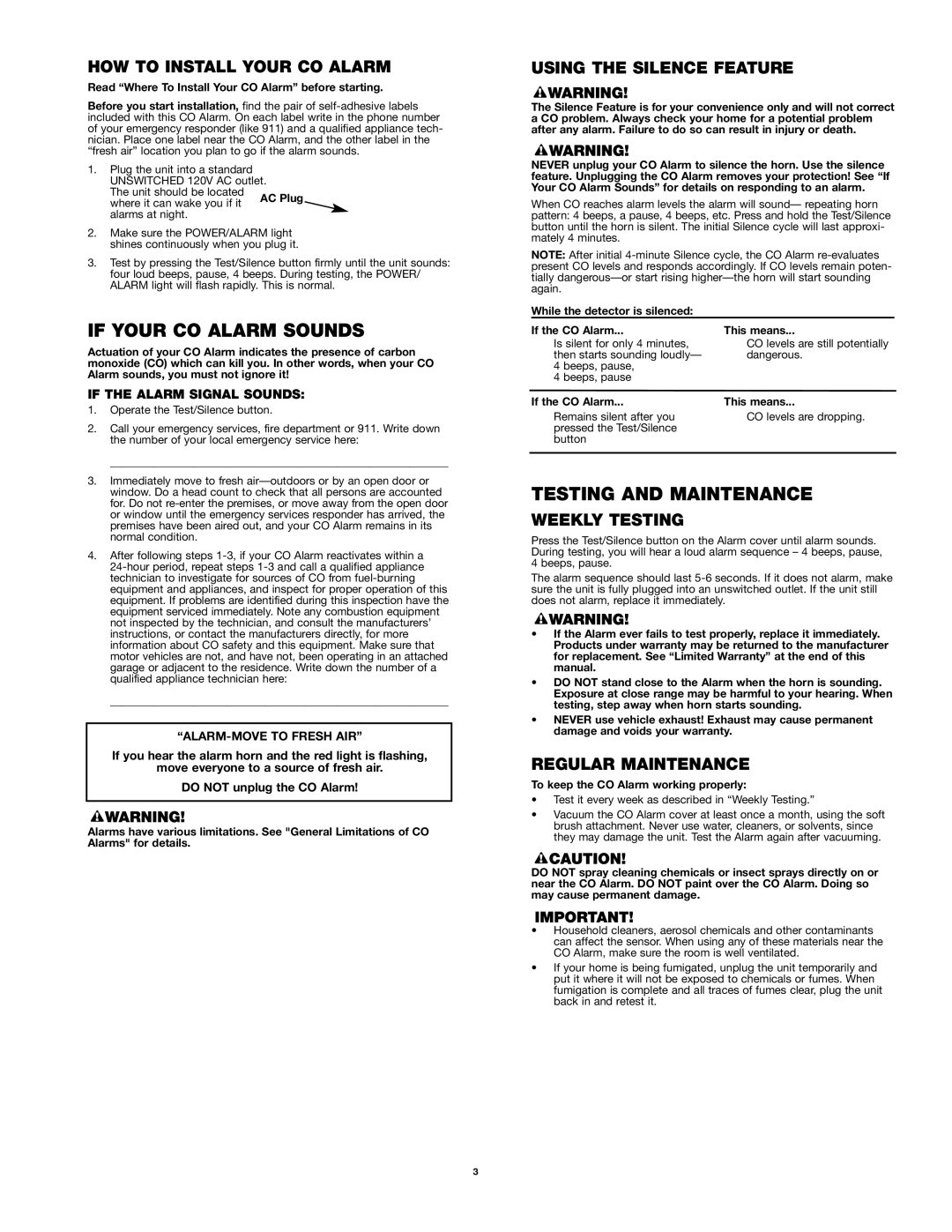HOW TO INSTALL YOUR CO ALARM
Read “Where To Install Your CO Alarm” before starting.
Before you start installation, find the pair of self-adhesive labels included with this CO Alarm. On each label write in the phone number of your emergency responder (like 911) and a qualified appliance tech- nician. Place one label near the CO Alarm, and the other label in the “fresh air” location you plan to go if the alarm sounds.
1.Plug the unit into a standard UNSWITCHED 120V AC outlet.
The unit should be located where it can wake you if it alarms at night.
2.Make sure the POWER/ALARM light shines continuously when you plug it.
3.Test by pressing the Test/Silence button firmly until the unit sounds: four loud beeps, pause, 4 beeps. During testing, the POWER/ ALARM light will flash rapidly. This is normal.
IF YOUR CO ALARM SOUNDS
Actuation of your CO Alarm indicates the presence of carbon monoxide (CO) which can kill you. In other words, when your CO Alarm sounds, you must not ignore it!
IF THE ALARM SIGNAL SOUNDS:
1.Operate the Test/Silence button.
2.Call your emergency services, fire department or 911. Write down the number of your local emergency service here:
_____________________________________________________________
3.Immediately move to fresh air—outdoors or by an open door or window. Do a head count to check that all persons are accounted for. Do not re-enter the premises, or move away from the open door or window until the emergency services responder has arrived, the premises have been aired out, and your CO Alarm remains in its normal condition.
4.After following steps 1-3, if your CO Alarm reactivates within a
24-hour period, repeat steps 1-3 and call a qualified appliance technician to investigate for sources of CO from fuel-burning equipment and appliances, and inspect for proper operation of this equipment. If problems are identified during this inspection have the equipment serviced immediately. Note any combustion equipment not inspected by the technician, and consult the manufacturers’ instructions, or contact the manufacturers directly, for more information about CO safety and this equipment. Make sure that motor vehicles are not, and have not, been operating in an attached garage or adjacent to the residence. Write down the number of a qualified appliance technician here:
_____________________________________________________________
“ALARM-MOVE TO FRESH AIR”
If you hear the alarm horn and the red light is flashing,
move everyone to a source of fresh air.
DO NOT unplug the CO Alarm!
Alarms have various limitations. See "General Limitations of CO Alarms" for details.
USING THE SILENCE FEATURE
The Silence Feature is for your convenience only and will not correct a CO problem. Always check your home for a potential problem after any alarm. Failure to do so can result in injury or death.
NEVER unplug your CO Alarm to silence the horn. Use the silence feature. Unplugging the CO Alarm removes your protection! See “If Your CO Alarm Sounds” for details on responding to an alarm.
When CO reaches alarm levels the alarm will sound— repeating horn pattern: 4 beeps, a pause, 4 beeps, etc. Press and hold the Test/Silence button until the horn is silent. The initial Silence cycle will last approxi- mately 4 minutes.
NOTE: After initial 4-minute Silence cycle, the CO Alarm re-evaluates present CO levels and responds accordingly. If CO levels remain poten- tially dangerous—or start rising higher—the horn will start sounding again.
While the detector is silenced:
If the CO Alarm... | This means... |
Is silent for only 4 minutes, | CO levels are still potentially |
then starts sounding loudly— | dangerous. |
4 beeps, pause, | |
4 beeps, pause | |
If the CO Alarm... | This means... |
Remains silent after you | CO levels are dropping. |
pressed the Test/Silence | |
button | |
| |
TESTING AND MAINTENANCE
WEEKLY TESTING
Press the Test/Silence button on the Alarm cover until alarm sounds. During testing, you will hear a loud alarm sequence – 4 beeps, pause, 4 beeps, pause.
The alarm sequence should last 5-6 seconds. If it does not alarm, make sure the unit is fully plugged into an unswitched outlet. If the unit still does not alarm, replace it immediately.
•If the Alarm ever fails to test properly, replace it immediately. Products under warranty may be returned to the manufacturer for replacement. See “Limited Warranty” at the end of this manual.
•DO NOT stand close to the Alarm when the horn is sounding. Exposure at close range may be harmful to your hearing. When testing, step away when horn starts sounding.
•NEVER use vehicle exhaust! Exhaust may cause permanent damage and voids your warranty.
REGULAR MAINTENANCE
To keep the CO Alarm working properly:
•Test it every week as described in “Weekly Testing.”
•Vacuum the CO Alarm cover at least once a month, using the soft brush attachment. Never use water, cleaners, or solvents, since they may damage the unit. Test the Alarm again after vacuuming.
DO NOT spray cleaning chemicals or insect sprays directly on or near the CO Alarm. DO NOT paint over the CO Alarm. Doing so may cause permanent damage.
•Household cleaners, aerosol chemicals and other contaminants can affect the sensor. When using any of these materials near the CO Alarm, make sure the room is well ventilated.
•If your home is being fumigated, unplug the unit temporarily and put it where it will not be exposed to chemicals or fumes. When fumigation is complete and all traces of fumes clear, plug the unit back in and retest it.

